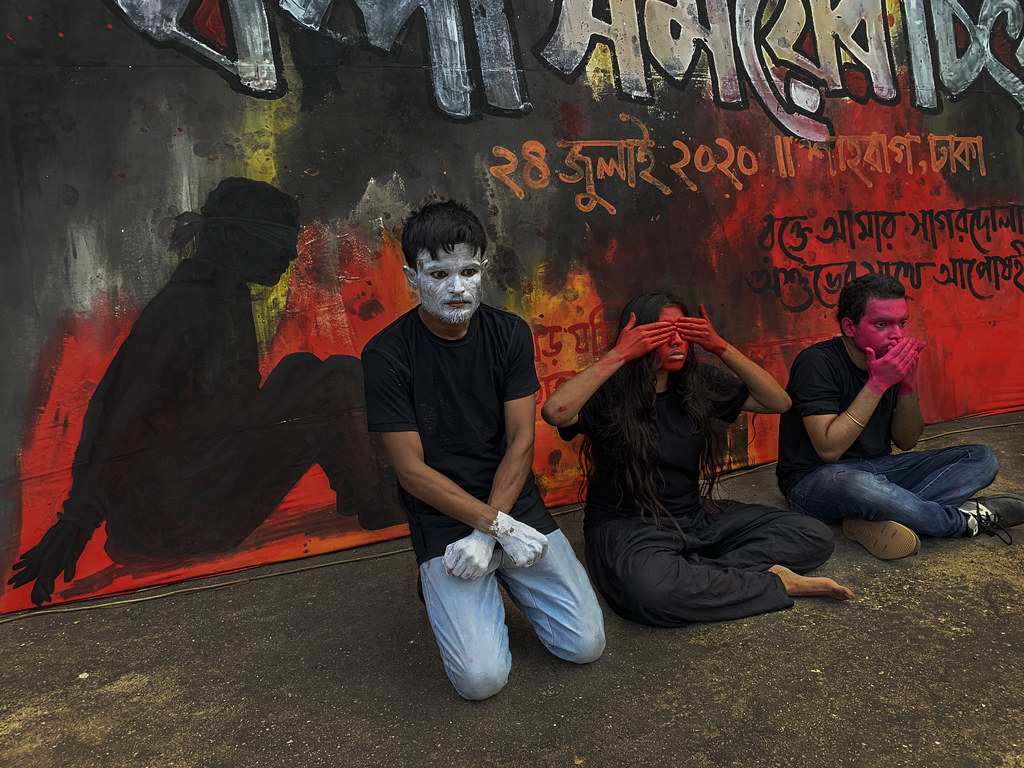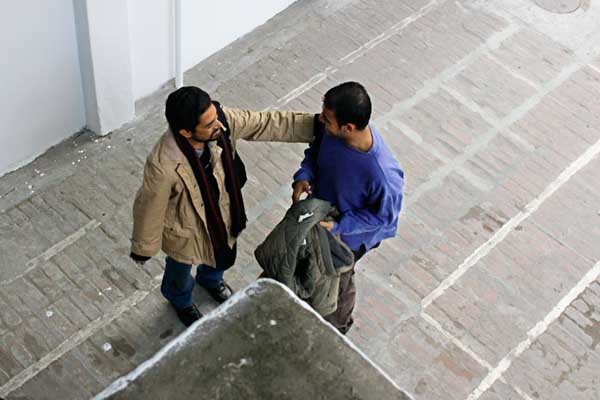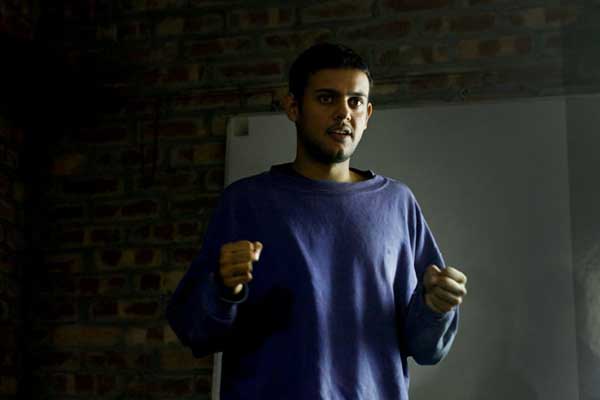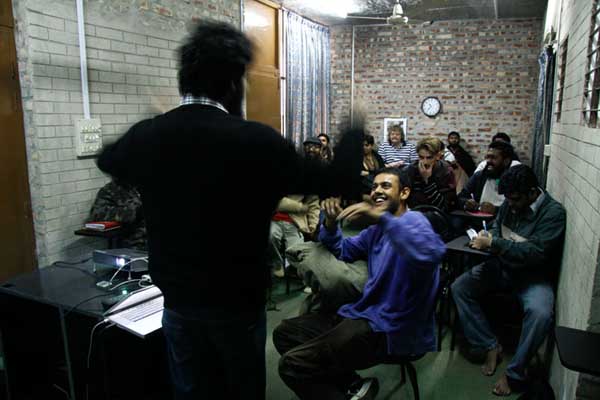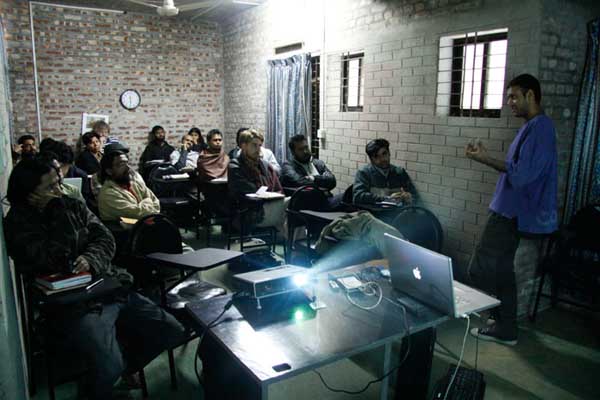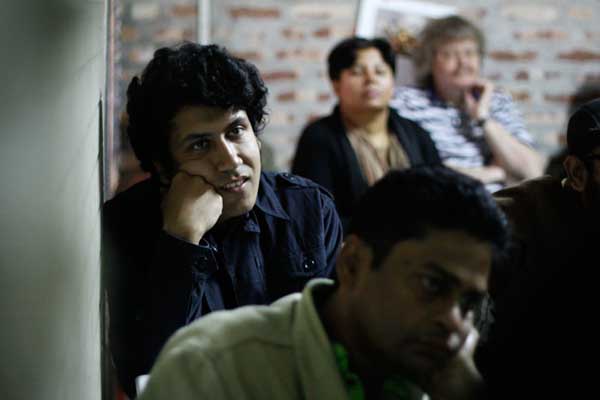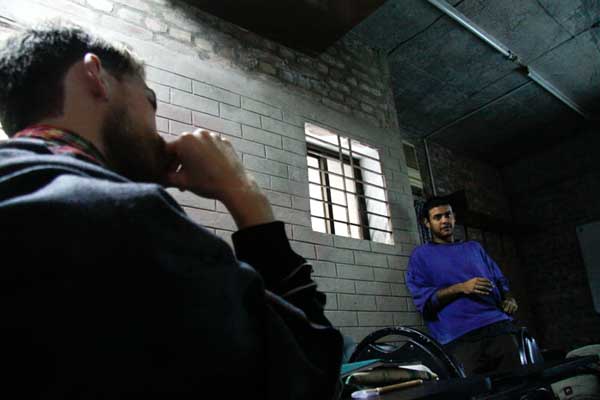Happy February!
We are in the middle of a very stimulating workshop with 14 Bangladeshi, Nepali and Norwegian students and award winning photographer Philip Blenkinsop. The workshop is the beginning of an extended exchange program where participating students will produce an in-depth photo reportage project.
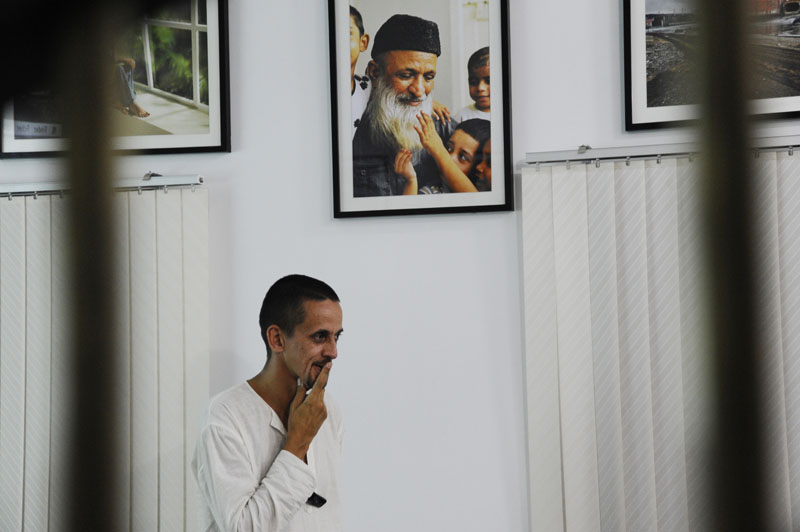
Philip Blenkinsop has been described as “one of the most essential photographers of his generation” (Christian Caujolle). He is adamant that the photographer should never censor scenes through the camera. ?Photographers are both witnesses and messengers. Our responsibility must always lie with the people we focus on, and with the accurate depiction of their plight, regardless of how unpalatable this might be for magazine readers.? His work, published in international arenas, has been the catalyst for much discussion and amongst other accolades was awarded Amnesty International?s Photojournalism prize for excellence in human rights journalism. Continue reading “”
Tag: Learning
Pathshala admission
Subscribe to ShahidulNews
![]()
Pathshala – South Asian Media Academy was established in Dhaka in 1998 to fulfill the long felt need for providing institutional education in photography in Bangladesh. Today Pathshala is one of the premier institutes of photography in Asia. With a visiting faculty consisting of the finest professionals in the world, the school boasts a teaching programme that is second to none. Students have won major international awards (World Press Photo, Asahi Shimbun, National Geographic All Roads Contest etc.) and take on assignments for the most prestigious international publications (Time Magazine, Newsweek). Within a short period, Pathshala has established itself as a regional centre for excellence in photography, attracting students from India, Nepal, Norway, Denmark, Pakistan, Singapore, South Africa, the UK and Zimbabwe. Pathshala is affiliated to Bolton University (UK), the Danish School of Journalism and Sunderland University (UK).
Pathshala invites application and portfolio from interested students for enrollment in the
Three years professional course on photography.
Eligibility/ Admission Requirement:
– HSC / A level (Minimum Second class / GPA 2.5)
– Fluent in spoken and written English
– Completion of basic or foundation course in photography
– Portfolio with ten photographs (Size: 8″x10″)
– Curriculum vita with two referees
– Two passport and two stamp size photographs
– Brief written explanation justifying interest in the programme
Important Dates:
Portfolio Submission deadline: 25th September, 2011
Interview: 27th September 2011
Interview Result: 27th September 2011
Admission deadline: 29th September 2011
Class starts: 9th October 2011
For more information please see, www.pathshala.net.
Hasib Zakaria
Vice Principal
Pathshala South Asian Media Academy
PhD Researcher
Archeology & Art
Vrije University Brussels
Belgium
Beyond Walls Outside Frames
Subscribe to ShahidulNews
![]()
A photographer is rarely a good editor of one?s own photographs. It?s not as illogical as it sounds. The visual content within the four corners of a frame create the stimulus that inform us of what was seen, and in well crafted images, conjure up the sense of the moment. For the photographer, it is a small part of the process. The pain, the pleasure, the frustrations, the high, of arriving at the photograph, is an inseparable part of the image. The editorial choice therefore, cannot be made on the image alone. The emotional weight impinges upon one?s judgment. It is a valid choice, but one that the viewer unencumbered by that weight, is incapable of sharing, and hence a choice, less relevant to the viewer.
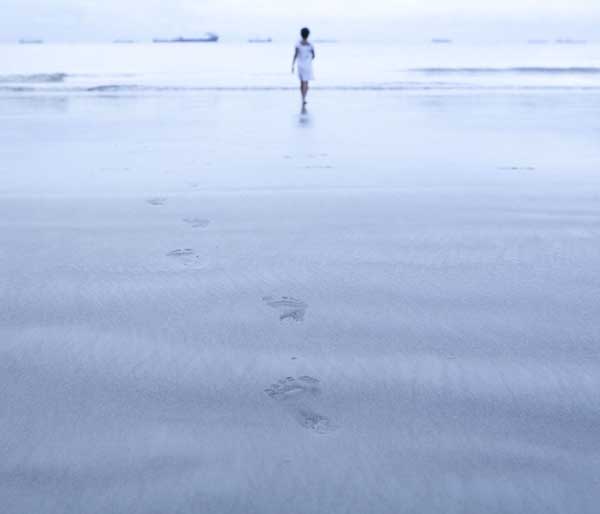
A teacher in selecting work by students goes through a similar process. The path is neither smooth nor predictable. Students with different ability, drive, tenacity and energy occupy a classroom. Work produced by a student one has nurtured over years is difficult to reduce to a set of visual frames. The coaxing, cajoling, willing and hand holding that has gone into each student. The stance one has taken, stern but generous, appreciative but demanding, kind but rigorous, finds its way into each image. Each portfolio has a stamp, invisible to others but clearly present to the teacher. How then does one take a dispassionate view, while selecting work for a collective publication?
Of course there is the chronology that maps out the growth of the organisation. The transitions that have taken place, contoured by collective experiences. The visiting faculties who have left lingering traces upon individual styles. Influences that have sometimes dramatically altered the visual practice. Return to familiar paths. Explorations into the unknown. Blatant copies arising out of adulation. Rejection, rethinking, a process of morphing where the old and the new have combined to produce a new genre altogether, are easy to observe. The branches can be traced to the roots with every knurled knot, every fork, every green shoot a sign of a new beginning.
Then comes the difficult part. When bright sparks of brilliance shine through in defiance. When a body of work refuses to be categorised. When another, just as strong, pulls in a different direction. How does one choose between favourites? How does one forget the angst that led to a new vision? When a student returns from being almost lost, and basks in new-found confidence, can work be excluded, merely because it doesn?t fit? Can brilliance be ignored merely because there are other stories to tell, and there just isn?t enough room?

Other dynamics also enter the equation. Talent and success don?t always go hand in hand. Having taught one?s students survival skills, one must appreciate their ability to get ahead, make the right impressions, learn to play the ?game?. In that game of life, there are those one admires more, for their integrity and honesty. For staying true to their beliefs. For not selling out. That the less scrupulous are sometimes the ones who shine is a reality one needs to accept. Having handed over the tools, one cannot hold back. It is arrogant to assume one?s value systems will be valued by all. In the rough and tumble of survival, many will choose options one might not fully subscribe to. Many will walk paths, one would hope they would avoid. Some will deceive, some will massage the truth. Some will benefit as a result. That too is reality.
When a reject pile is so rich with nuggets how does one lament? What message does it carry when rejection is so value loaded? When rejected work is seen as inferior. When the editors sword can affect careers, change lives. In the binary of inclusion, there is no middle path. No also-rans. Work is in, or out. The pain of losing out is not easily shared.
Hopefully, the book will speak for itself. While regretting what has been lost, one must not fail to rejoice in what is present. Inevitably there are internal references. New work that is informed by former attempts. While other bodies of work have marked the path for future students to follow. Global influences have also pitched in, but generally, it is the peers who have paved the way for future students.
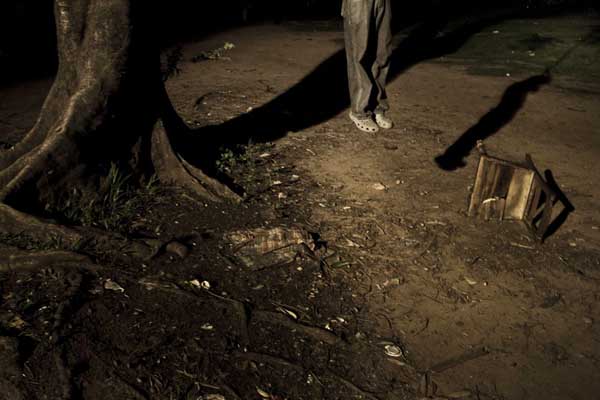
The early work of Abir Abdullah, produced at a time when the genre of photo essays was largely unexplored in Bangladesh, was emulated by others in his own batch like GMB Akash. Akash himself became a trendsetter for future students. The gritty colours of Andrew Biraj and the ethereal black and whites of Munem Wasif took divergent exploratory routes while their classmate Nazrul Islam, found inroads into contemporary life in Kabul. The exquisite image construction of Saiful Huq Omi was perhaps the precursor of the equally accomplished sculptural images of Khaled Hasan. Din Mohaammad Shibly?s exploration of family life might well owe to the tender insight by Munira Morshed Munni into the intimacies of her own home. The stark rendering of the invisible gay community by Gazi Nafiz Ahmed, might have evolved from the very different approach that Akash had taken many years earlier, while Masud Alam Liton stayed closer to the early documentary style. Noor Alam?s insightful look at children with thalassaemia surely gained from the work on children with cancer by Nayemuzzaman Prince.
Choosing from the 8th batch was particularly challenging. While the individual styles of Debashish Shom, Shehab Uddin and Shumon Ahmed have all made it to the book, the ones left out include important work by Chandan Robert Rozario, the strong graphic imagery of K M Asad, the harrowing story by Saikat Majumder and the exquisite well-crafted frames of Khaled Hasan. The distinctive approaches of Tanvir-ul-Hossain and Nurun Nahar Nargish, could have represented the new contemporary movement in Bangladeshi photography. They too got bypassed because more thought provoking work was on offer.
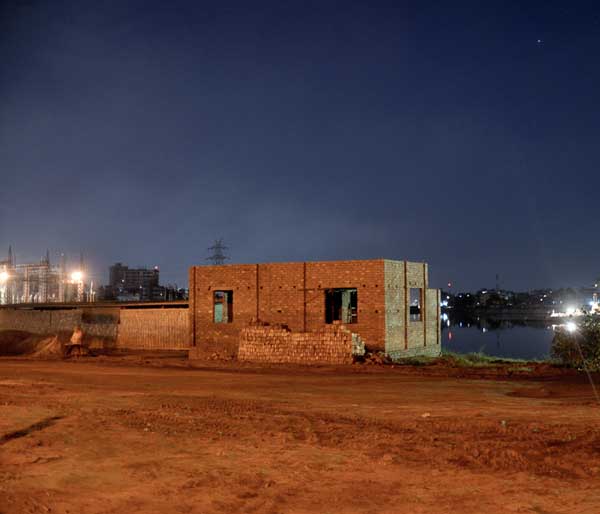
Taslima Akhter brings us face to face with the inequalities of class that fuel our growing economy, but lost were Ashraful Awal Mishuk?s insights into the Bangladeshi underworld. Giving up Syed Asif Mahmud?s dreamy visuals was particularly heart wrenching. The well executed night scenes by Sarker Protick fought its way in, but it was the joy of seeing exciting, vibrant, exploratory work by the young photographers, Arifur Rahman, Rasel Chowdhury, Tushikur Rahman and Jannatul Mawa that got the adrenaline going. They refuse to be hemmed in by the four corners of a frame. They reject the notion of walls. This is Pathshala and Bangladeshi photography shamelessly showing off. Long may it do so.
Morten Krogvold workshop at Chobi Mela VI
Subscribe to ShahidulNews
![]()
The celebrated Norwegian photographer Morten Krogvold is one of Pathshala‘s favourite tutors. He is also a regular visitor to Chobi Mela. Morten’s show “Encounters” will be on display at the Bangladesh Shilpakala Academy Gallery from the 21st January 2011.
Photos by K M Asad



Chobi Mela VI workshops begin
Subscribe to ShahidulNews

Indian photographer Sohrab Hura is conducting a workshop ?Untitled? with the 2nd year student?s of Pathshala. The workshop theme for everyone is CARTE BLANCHE, which means everyone is free to do whatever s/he wants. It will continue till 21st January 2011.
Photographs by K M Asad
Changing the Face of Photography
![]()
![]()
Pathshala, The South Asian Institute of Photography celebrates its 10th anniversary
Elita Karim
Star Weekend Magazine Volume 7 Issue 5 February 8 2008
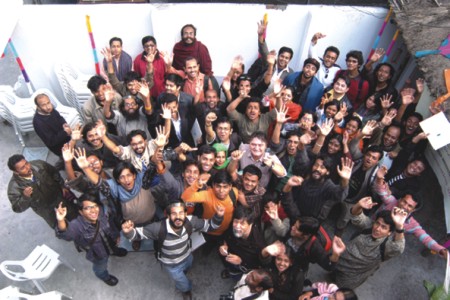 ?D. M. Shibly
?D. M. Shibly
Members of the Pathshala family have a lot to celebrate. ?My son had once written an essay in class, where he wrote that his mother is a photographer,? says Munira Morshed Munni, freelance photographer, photo editor at Drik News and teacher at Pathshala. She is also one of the first students of Pathshala, and has been with the school for the last ten years. ?His teacher, upon reading the line, immediately cut it out, assuming it to be a mistake made by the child. Later on, I had to go speak to her and explain that I really am a photographer and also make a living out of it. She was dumbstruck for a while.? You can’t blame the teacher, adds Munni. It is still very difficult for the society to accept this art-form as anything but a hobby, a side interest or a skill that is more or less limited to documenting wedding receptions or capturing nice images. Most people are unaware of the detailed calculations made by the seasoned photographer, of the possible number of angles that can be used for one shot, or the analysis of composition, frame and subject in the blink of an eye.
 Left to Right ? Saikot Majumder, Sazzad Ibne Syed, Abir Abdullah
Left to Right ? Saikot Majumder, Sazzad Ibne Syed, Abir Abdullah
Pathshala, The South Asian Institute of Photography, located on Panthapath, has played a pivotal role in the last decade, in changing the social attitude towards photography as a profession. Offering basic and advanced levels courses in this field, the institution also offers diploma and Bachelor equivalent courses to students. Very soon, a Master’s level programme will also begin in collaboration with the University of Liberal Arts. The school is also a part of the upcoming regional Master’s programme between universities in Bangladesh, China, Indonesia, Nepal, Norway and Pakistan.
Back in 1998, Pathshala had begun as a part of a three-year World Press Photo educational initiative in 1998. As the name Pathshala symbolises the ancient education system held in the open air, under the shade of a tree, free from the confining walls of a classroom, the institute emphasised on not merely conventional teaching the students. It allowed students to ask questions and develop their own style and perspective. The school was designed in a way that leads students to experience knowledge beyond the confines of the discipline.
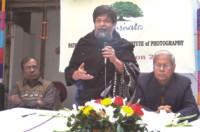 Dr. Shahidul Alam speaking on the institute’s anniversary ? D. M. Shibly
Dr. Shahidul Alam speaking on the institute’s anniversary ? D. M. Shibly
According to Shahidul Alam, the Principal of the school and MD of Drik, Pathshala strives to do much more than teach photography. ?It is about using the language of images to bring about social change. It is about nurturing minds and encouraging critical thinking. It is about responsible citizenship. In a land where textual literacy is low, it is about reaching out where words have failed. In a society where sleek advertising images construct our sense of values, studying at Pathshala is about challenging cultures of dominance.? Dr. Shahidul Alam speaking on the institute’s anniversary. According to Alam, in the South Asian region, the need for a structured education in photography has always been felt. Since photography plays a significant role in the mainstream media, this need is mostly felt in the field of photojournalism. ?The people’s right to information is generally not recognised by the official media in many countries,? he says. ?This is clearly also true for the SAARC (South Asian Association for Regional Co-operation) nations. The lack of sufficient professional skills in the media, especially in the field of photojournalism, has also allowed successive governments to pass on propaganda in place of news, and the people’s role in governance has been totally ignored.? Interestingly enough, most students, who go to this school, are studying subjects like Engineering, Medicine, BBA at other universities to comply with the conventional social mindsets. There are some, however, who end up choosing between passion and tradition, hence letting go of the so-called educational system approved by society. One such student is Azizur Rahman Peu, editor of Drik News, teacher at Pathshala and also one of the first students to have entered the school ten years ago. ?I was studying medicine in Rongpur,?he says, ?when I practically ran away from home to Dhaka. I wanted to be a journalist. Back then, I didn’t know how one would define a journalist. I used to think that a photographer was, obviously, what described a journalist, capturing and documenting moments in history. My love for photography, eventually, led me to start studying here at Pathshala.? Pathshala’s certificate awarding ceremony. Blaming not only the social net, but also the media in Bangladesh, students claim that even inside newsrooms, photographers are not given their worth. A photograph tells a story as well, which should complement the journalist’s written work, rather than act as a side support. ?Newsrooms have news editors,? says Shahidul Alam. ?However, the concept of a photo editor is not seen in newspaper offices here.? According to Alam, it was the Independent in the UK which had practically revolutionised the way photographs were used in newspapers, hence breaking the system. ?Other newspapers like the Guardian had to eventually accept this idea as well.? Pathshala also has regular academic exchanges between Oslo University College in Norway and Edith Cowan University (ECU) in Australia. It is not really an exchange programme, since students from these countries come to Bangladesh to learn about photography and not the other way around, adds Alam. However, this provides Pathshala students an opportunity to share experiences with students of very different backgrounds. ?The long-term partnerships with Sunderland University, Bolton University and the Danish School of Journalism, offer educational opportunities for students with other world class institutions. The internship opportunities at Drik, Chobi Mela and Drik News offer on-the-job training that is invaluable in professional life. The regular participation in international festivals and workshops provide a world-view essential to becoming established in the global marketplace. And then there is the acid test. Emerging students are in demand, and ever since Pathshala started, all students who have graduated are gainfully employed. Some are already at the very top of their profession,? says Alam. Celebrating a decade with fireworks. Norman Leslie, the programme director from ECU, says that his students have had the chance to experience life in all its reality and colours through this exchange programme. ?ECU is located in Perth, which is a city extremely isolated even in Australian terms,? says Norman. ?Students from this university, besides having the advantages of international exposure through this programme, have also created a certain bond between the two cultures which is extremely important when it comes to the art of photography.? Even though passionate about art and photography from an early age, Shahidul Alam had decided to take up photography as a profession by accident. Back in the 80s, Alam was doing his PhD in Chemistry in the United Kingdom. As was the norm and still is in the society, studying a proper subject define the integrity and depth of being a true man. ?And that is what my parents believed as well,? says Alam. ?I did not have much money and would work to pay my tuitions.? One of his close friends got into the airlines business and asked him to fly to the United States with him. ?A poor student like me would never get this opportunity ever again and so I decided to go. My friend in the UK asked me to bring him back a camera since cameras were cheaper in the US.? Alam got a full set complete with a tripod and lens and got back to the UK, only to find that his friend did not have the money to pay him back. ?And I was stuck with it!? laughs Alam. Pathshala recently entered its tenth year. Celebrating the school’s anniversary, a three day festival was organised where both the old and the new students presented their works, amidst other festivities.
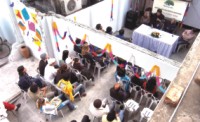 Pathshala’s certificate awarding ceremony ? D. M. Shibly
Pathshala’s certificate awarding ceremony ? D. M. Shibly
A photography exhibition titled ?Studying Life? began marked the beginning of the festival on February 1 at the Drik Gallery. Exhibiting works by some of the most celebrated students of the school, this event was inaugurated by Atiqul Huque Chowdhury and Dr. Shahidul Alam. The exhibition, which will continue up to February 15, features thirty six photographers, including Munem Wasif, Abir Abdullah, GMB Akash, Tanvir Ahmed and many more. On February 2, certificates were distributed to the students who had finished their respective courses, starting from the basic to the undergraduate level. ?We had a full-fledged festival, complete with a winter Pitha Utshob,? says Joseph Rozario, the Administrative Manager of Pathshala. ?Students, teachers, along with a few photographers from outside the country had discussions on photography. These photographers also presented some of their unique works. The day ended with a film made by one of our own students,? he says.
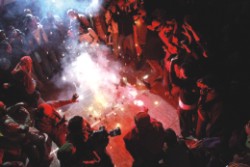 Celebrating a decade with fireworks ?D. M. Shibly
Celebrating a decade with fireworks ?D. M. Shibly
The last day of the festival, February 3, was an ?absolute blast,? according to Din M Shibly, a Pathshala graduate who now teaches at the school and works for the monthly magazine Ice Today. The highlight of the day was when Prachyanat, the musical theatre group, performed at the school, much to the delight of the students and also a number of guests who had turned up at the celebrations. The notion that photography cannot be a proper career no longer holds true. Many students from Pathshala are working in the media, both local and international. Tanveer Ahmed, student of Pathshala who now works at Drik News, recently had one of his photographs published in the Time magazine as the picture of the year. The photograph shows a grandfather carrying the dead body of his grandchild after being hit by the Sidr cyclone last year. Many other Pathshala students have won international awards. Alam says that young people believe that there is more glamour and less money in this profession. ?It is actually the other way around,? he explains. He plans to work more on visual literacy, hold workshops in schools and develop this field as an academic subject in the educational institutions in Bangladesh. Photography is much more than capturing a mere image. It is what one captures within the image; emotions, environment, thoughts, social perceptions and so on. One simply has to look into a photograph to discover these elements, rather than looking at it. As actor and author Sir Dirk Bogarde had put, ?The camera can photograph thought.?
